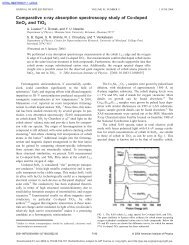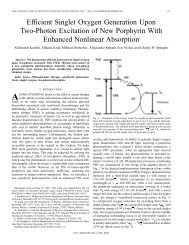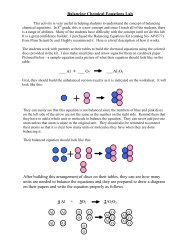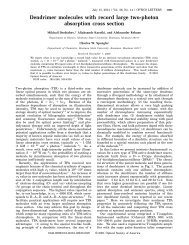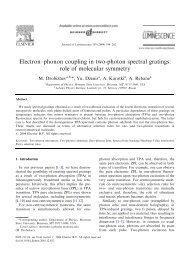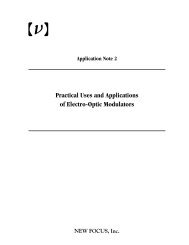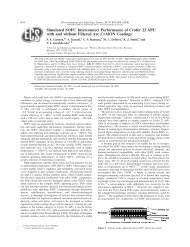Defects in inorganic photorefractive materials and their investigations
Defects in inorganic photorefractive materials and their investigations
Defects in inorganic photorefractive materials and their investigations
You also want an ePaper? Increase the reach of your titles
YUMPU automatically turns print PDFs into web optimized ePapers that Google loves.
Cr 3+<br />
Nb<br />
<strong>Defects</strong> <strong>in</strong> <strong>in</strong>organic <strong>photorefractive</strong> <strong>materials</strong> <strong>and</strong> <strong>their</strong> <strong>in</strong>vestigations 17<br />
. This f<strong>in</strong>d<strong>in</strong>g co<strong>in</strong>cides with results obta<strong>in</strong>ed by IR optical spectroscopy<br />
(see Sec. 8).<br />
The advantages of MCD-ODMR studies have been used for LN not only<br />
to l<strong>in</strong>k the EPR of the <strong>in</strong>tr<strong>in</strong>sic defect Nb 4+<br />
Li<br />
to its optical absorption [36]<br />
at 1.6 eV (Fig. 5) but also to study the optical properties of the extr<strong>in</strong>sic<br />
defects Ti 3+<br />
Li<br />
[36], Cr 3+ [90], Cu 2+ [91], Fe 3+ [91] <strong>and</strong> Mn 2+ [91]. Also Cr 3+<br />
<strong>in</strong> congruent LN:Mg was <strong>in</strong>vestigated with this technique [90].<br />
5 <strong>Defects</strong> <strong>in</strong> oxide perovskites<br />
5.1 BaTiO 3 (BT)<br />
The properties of BaTiO 3 (BT) as a <strong>photorefractive</strong> host material are well<br />
known [92]. It may suffice <strong>in</strong> the present context to rem<strong>in</strong>d that it is acentric<br />
below about 120 ◦ C, where a transition from the cubic to the ferroelectric<br />
tetragonal phase takes place, stable at room temperature <strong>and</strong> down to about<br />
8 ◦ C. Its large electrooptic coefficients [93] allow comparatively few optically<br />
transposed charge carriers to create measurable <strong>in</strong>dex changes. The features<br />
of many defects <strong>in</strong> BaTiO 3 have been identified by EPR, usually at low temperatures<br />
<strong>in</strong> the rhombohedral phase (T≤ 185K), <strong>and</strong> for some of them <strong>their</strong><br />
role <strong>in</strong> the <strong>photorefractive</strong> behavior of the material has been elucidated <strong>in</strong><br />
detail.<br />
Especially for defects <strong>in</strong> BT it is often observed that they can be recharged<br />
metastably to neighbor<strong>in</strong>g valencies under illum<strong>in</strong>ation; this allows the access<br />
to numerous EPR-active charge states with little preparatory effort. S<strong>in</strong>ce defects<br />
with changed charges have altered optical absorption characteristics, BT<br />
crystals thus usually are photochromic. On this basis a further EPR/optical<br />
method was developed which is able to assign optical absorption b<strong>and</strong>s to<br />
<strong>their</strong> microscopic orig<strong>in</strong>. An outl<strong>in</strong>e will be given below. Here we state already<br />
that it has the follow<strong>in</strong>g useful consequences: 1) The EPR-<strong>in</strong>formation,<br />
usually obta<strong>in</strong>ed at low temperatures, can be transferred to room temperature,<br />
where <strong>photorefractive</strong> devices are supposed to operate. 2) Also EPRsilent<br />
defects can be identified. 3) The question can be answered between<br />
which defects charge carriers are transferred under illum<strong>in</strong>ation. 4) The <strong>photorefractive</strong><br />
performance of a material can be predicted quantitatively rely<strong>in</strong>g<br />
only on EPR-based defect studies. We <strong>in</strong>troduce this EPR/optical method at<br />
the open<strong>in</strong>g of this Section because several results presented later will depend<br />
on it.<br />
The development of the method was started <strong>in</strong> order to unravel why Rh -<br />
dop<strong>in</strong>g of BT sensitizes the material for operation <strong>in</strong> the <strong>in</strong>frared. S<strong>in</strong>ce then<br />
the procedure has been applied to several further problems connected with<br />
the role of defects <strong>in</strong> the <strong>photorefractive</strong> effect [94, 95, 96, 97]. The useful<br />
<strong>in</strong>fluence of Rh on the <strong>photorefractive</strong> properties of BT has been discovered<br />
<strong>in</strong> 1993 by Ross et al. [98] <strong>and</strong> was <strong>in</strong>tensely studied <strong>in</strong> the follow<strong>in</strong>g years





